Samsung Galaxy S 5 Review
by Anand Lal Shimpi & Joshua Ho on April 8, 2014 12:00 AM EST- Posted in
- Smartphones
- Samsung
- Mobile
- Galaxy S 5
CPU Performance
The Galaxy S 5 marks the second Snapdragon 801 based device we've reviewed at AnandTech, the first being HTC's M8. I've gone through the Snapdragon 801 in depth already, but we're basically dealing with a reasonable upgrade to Snapdragon 800 on an improved 28nm HPm process. The bulk of the improvements impact GPU and ISP performance, but the SoC is just better overall. GS5 owners are lucky as all versions of the device that use Qualcomm silicon feature the MSM8974AC v3 SKU, which includes four 2.5GHz Krait 400 cores and a 578MHz Adreno 330 GPU.
| Snapdragon 800/801 Breakdown | ||||||||||
| SoC Version | Model | Max CPU Frequency | Max GPU Frequency | ISP | eMMC | DSDA | Memory IF | |||
| MSM8974VV | v2 | S800 | 2.2GHz | 450MHz | 320MHz | 4.5 | N | 800MHz | ||
| MSM8974AA | v2 | S800 | 2.3GHz | 450MHz | 320MHz | 4.5 | N | 800MHz | ||
| MSM8974AB | v2 | S800 | 2.3GHz | 550MHz | 320MHz | 4.5 | N | 933MHz | ||
| MSM8974AA | v3 | S801 | 2.3GHz | 450MHz | 320MHz | 5.0 | Y | 800MHz | ||
| MSM8974AB | v3 | S801 | 2.3GHz | 578MHz | 465MHz | 5.0 | Y | 933MHz | ||
| MSM8974AC | v3 | S801 | 2.5GHz | 578MHz | 465MHz | 5.0 | Y | 933MHz | ||
Although Samsung was the first major OEM to be caught cheating in Android benchmarks, it appears to have completely abandoned the practice with the Galaxy S 5's shipping software. Not only was I unable to find any evidence of the old cheats, I couldn't find any evidence of HTC's new subtle cheating either. The Galaxy S 5 appears to be clean as far as I can tell. Kudos to Samsung on doing the right thing, and I hope all other OEMs take this as a sign to stop the silliness.
For our performance tests I turned to our usual suite of browser and native applications. If there's one obvious takeaway from our CPU tests it's that despite having faster silicon than HTC's M8, the GS5 isn't always faster. I believe this has more to do with thermals than anything else. HTC's metal chassis is able to do a better job of dissipating heat than the GS5's plastic chassis. I don't believe there's a substantial impact on user experience, but it's interesting to note how choice in materials can have a performance impact like this.
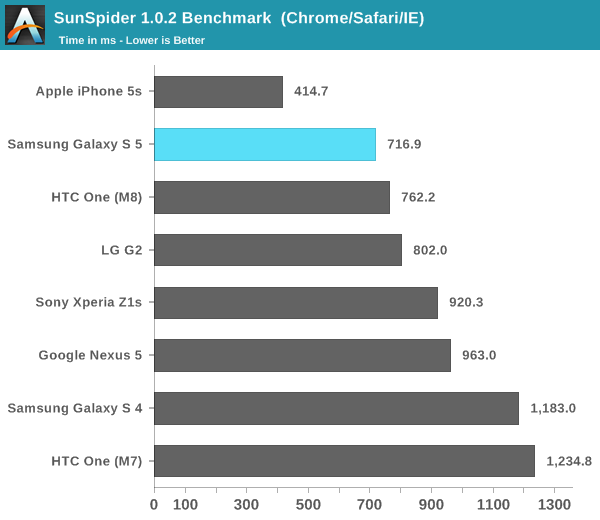
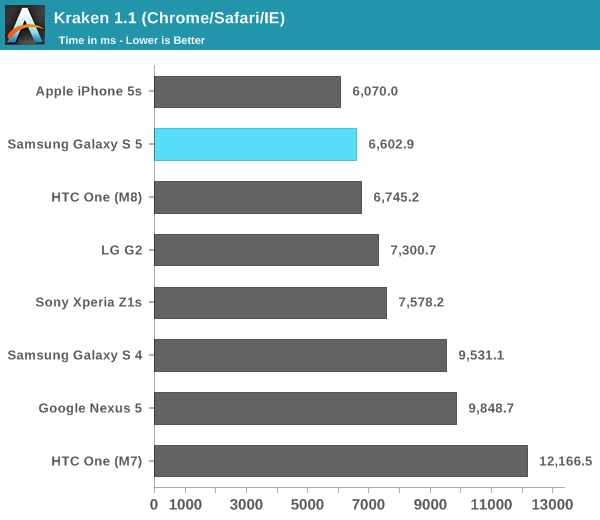
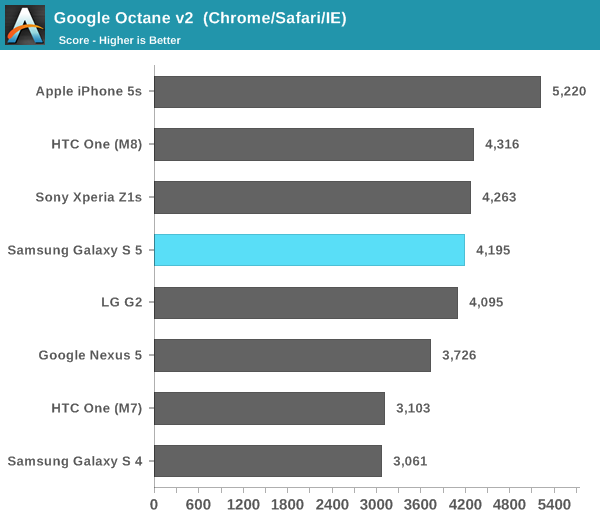
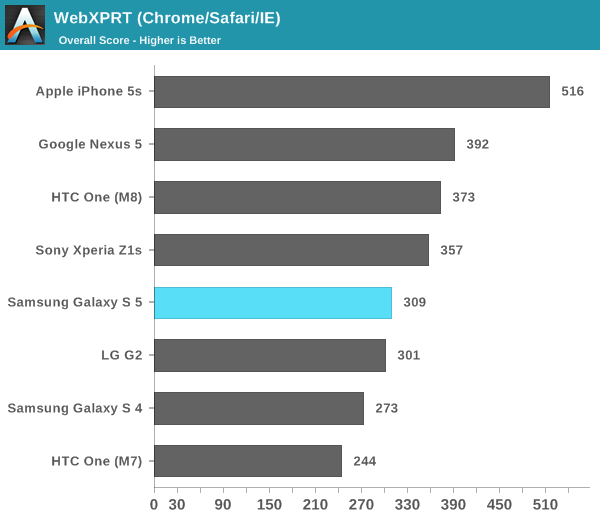
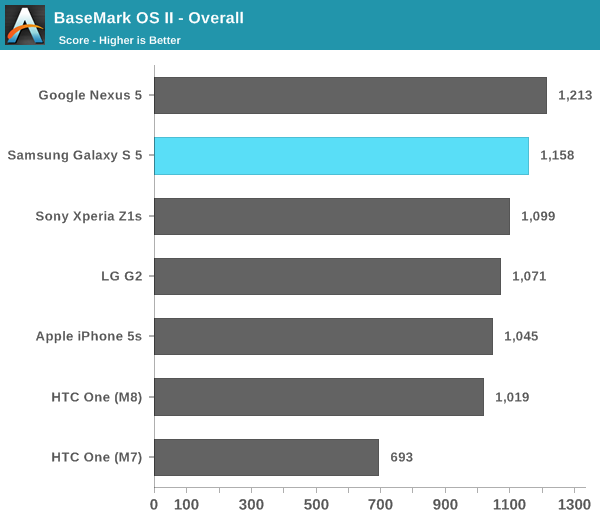
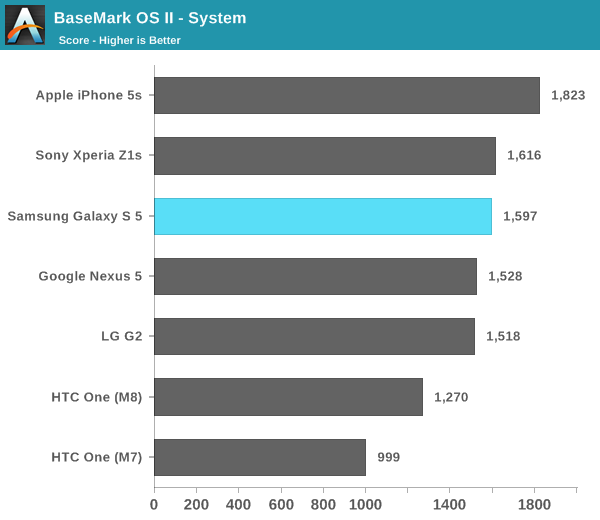
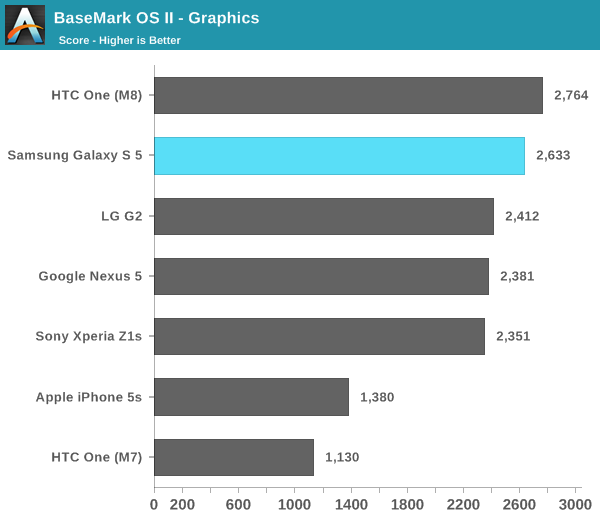

GPU Performance
GPU performance remains where we see the biggest benefit from Snapdragon 801 vs. 800, and since the GPU gains are almost entirely due to frequency scaling it's not too surprising that the M8 pulls ahead of the GS5 here in most cases.
There aren't any surprises here. The Adreno 330 in the Galaxy S 5 is more than capable of driving the device's 1080p display both in current and near term future 3D games.
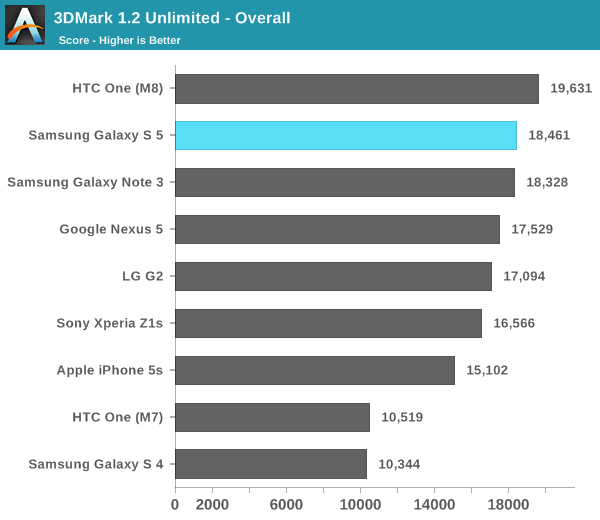
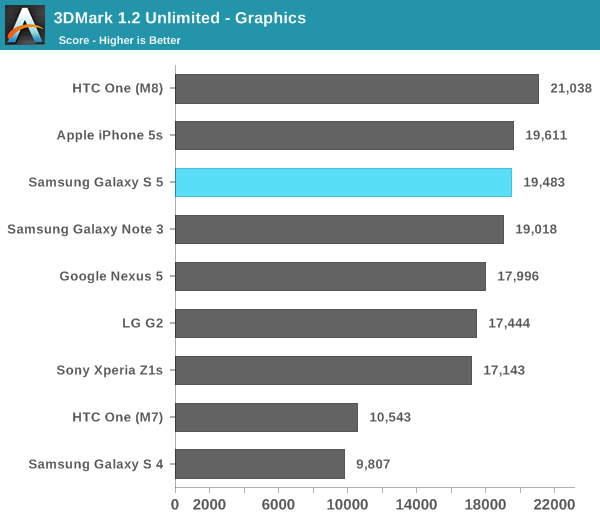
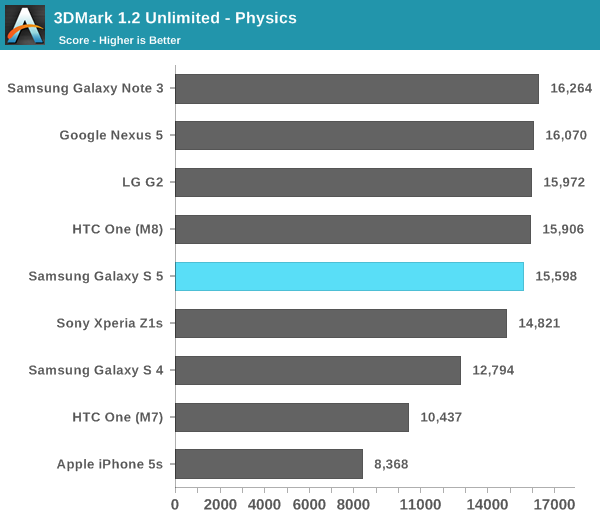
BaseMark X 1.1
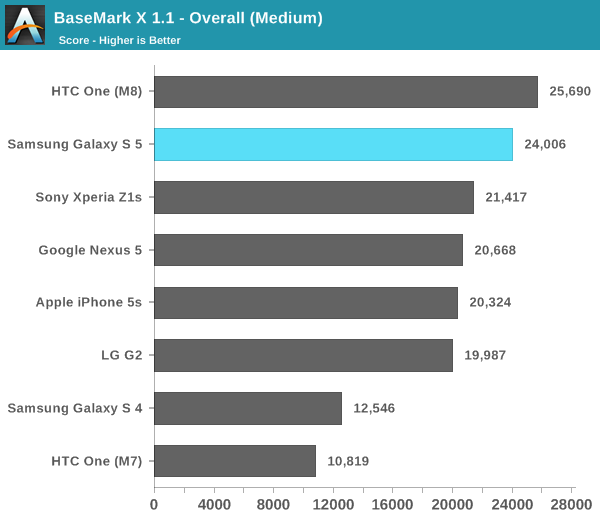

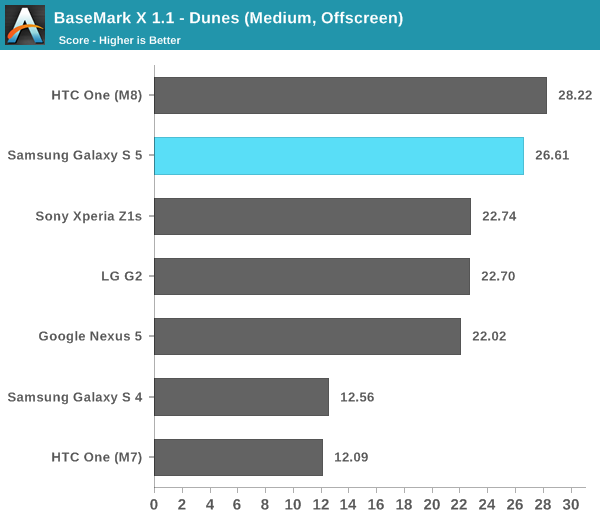
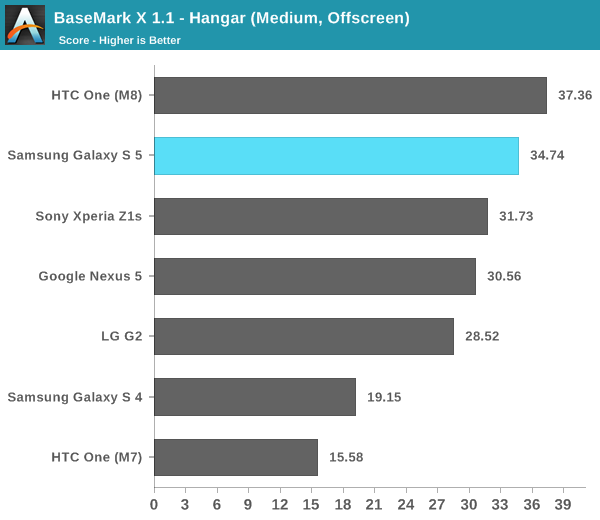

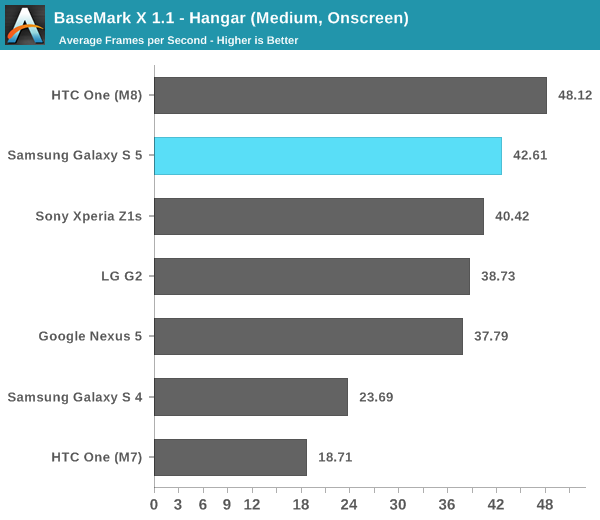
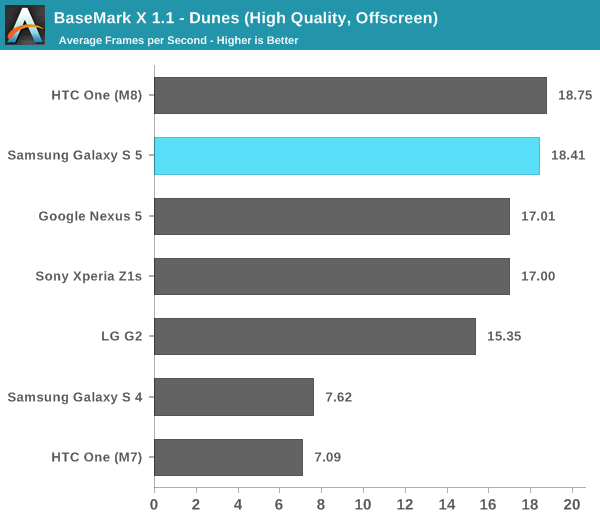
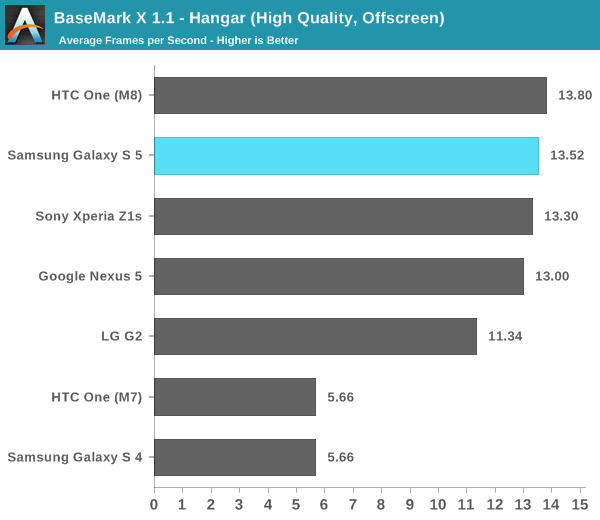
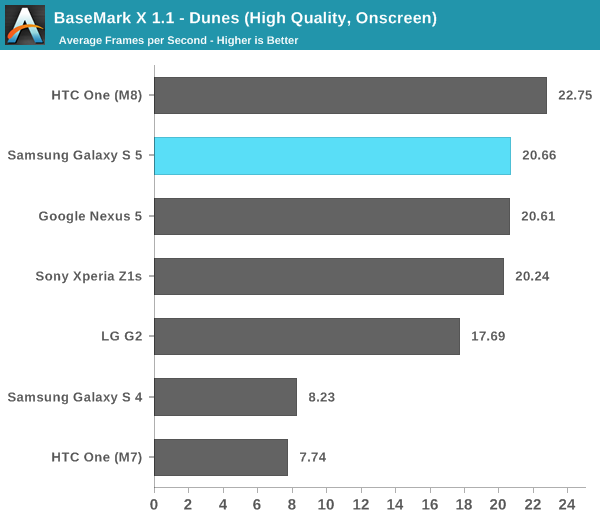
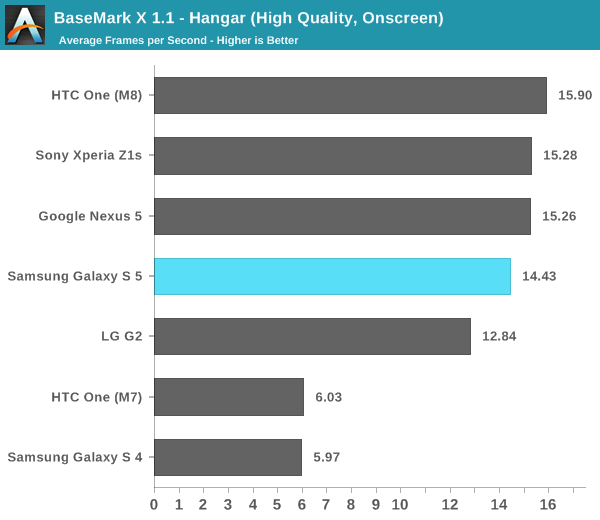
GFXBench 3.0
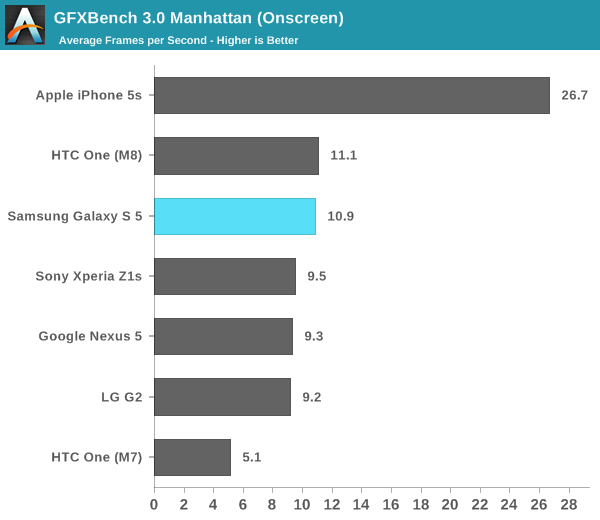
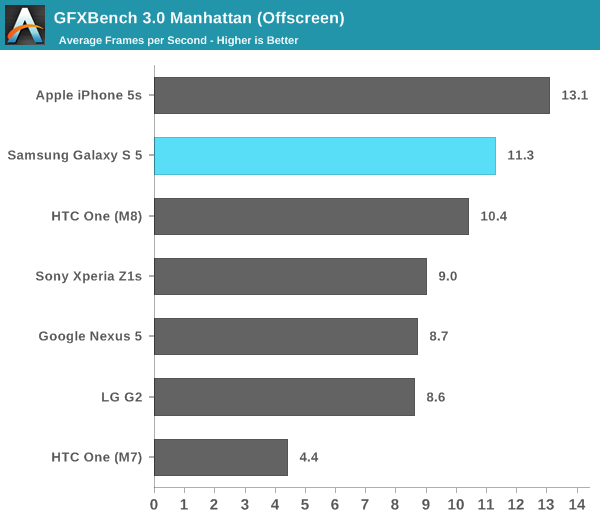
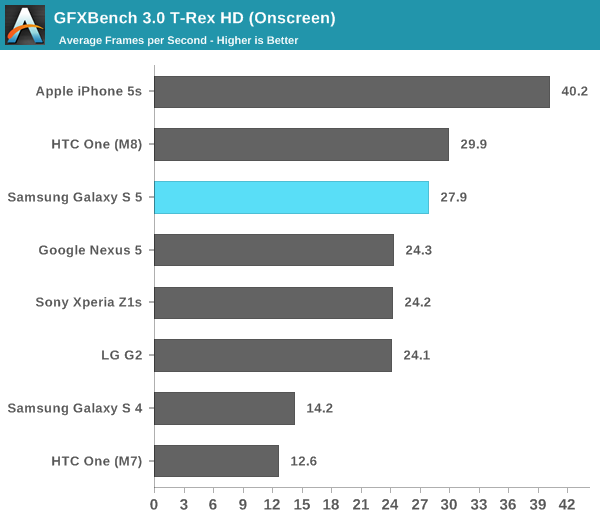
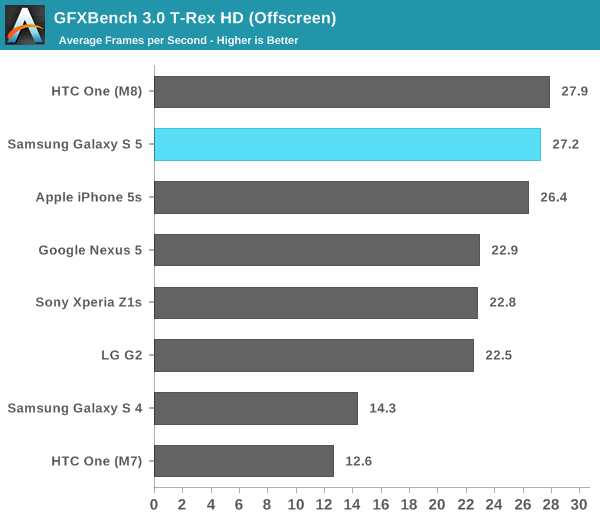

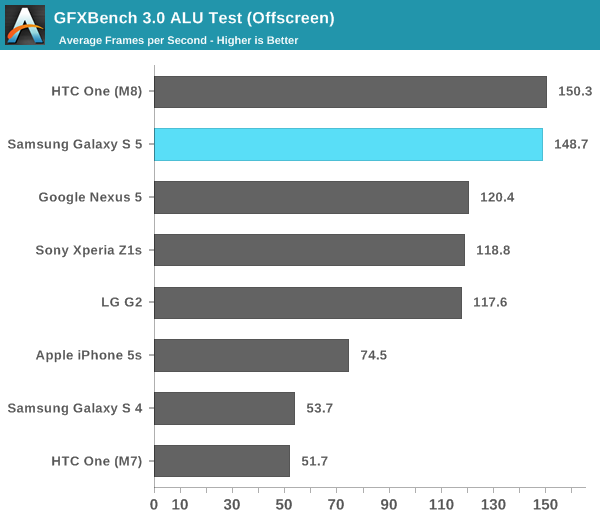


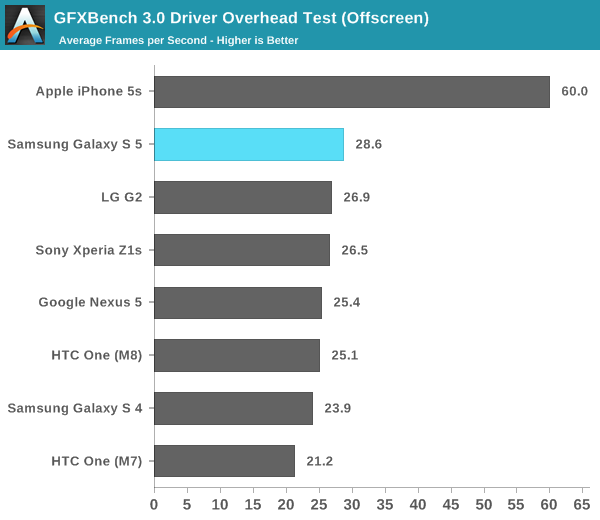
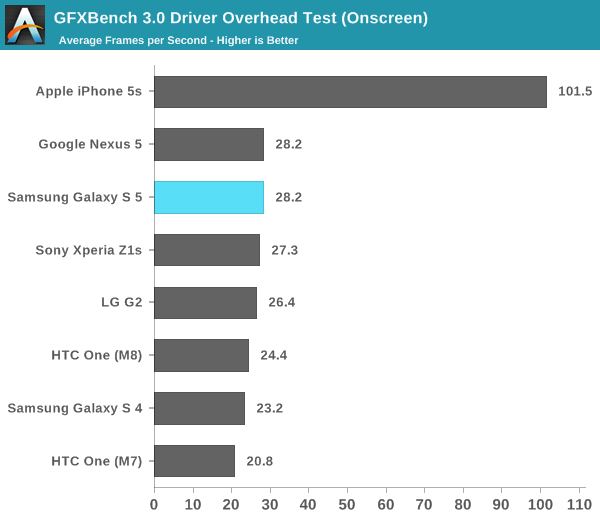
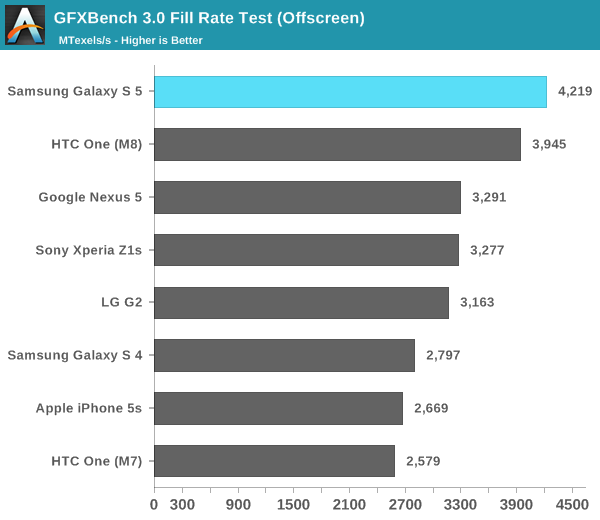
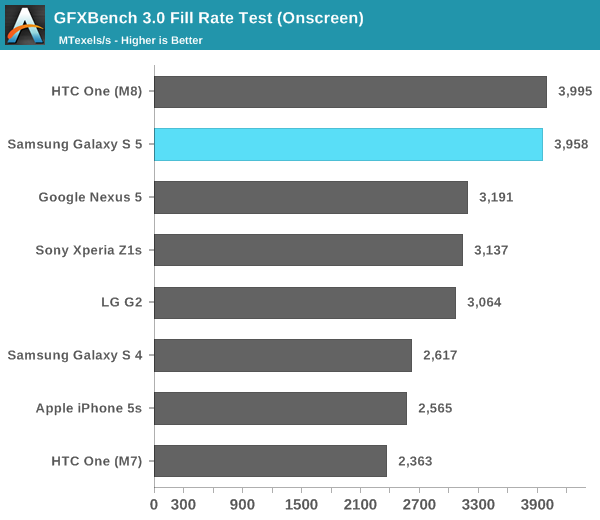
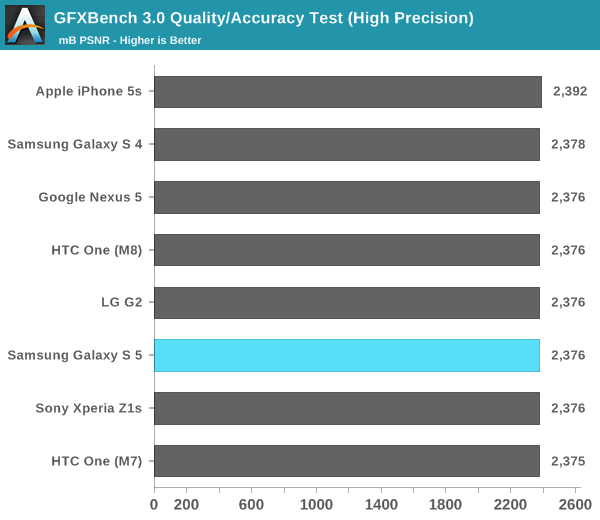
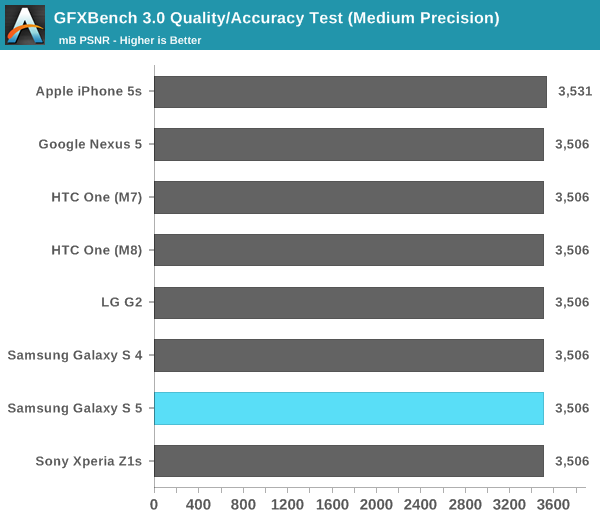
NAND Performance
The GS5 ships with 16GB or 32GB of NAND internally on an integrated eMMC device. Expansion is supported through a microSD card slot behind the removable back cover. Although the Snapdragon 801 inside supports eMMC 5.0, that alone doesn't guarantee a substantial increase in NAND performance. Keep in mind that most OEMs find multiple sources for their internal eMMC/NAND solutions, so what I'm testing here may only be representative of a portion of all GS5 devices.
Samsung sampled a 16GB GS5 review device. I put it through our usual random/sequential IO tests on a 100MB span of LBAs.
Random read performance is disappointing, it falls behind all modern devices we've tested. Random write performance is middle-of-the-road at best. It's unclear to me if this is a cost optimization or a lack of concern for NAND performance, but either way I'd rather see these metrics improve rather than regress.
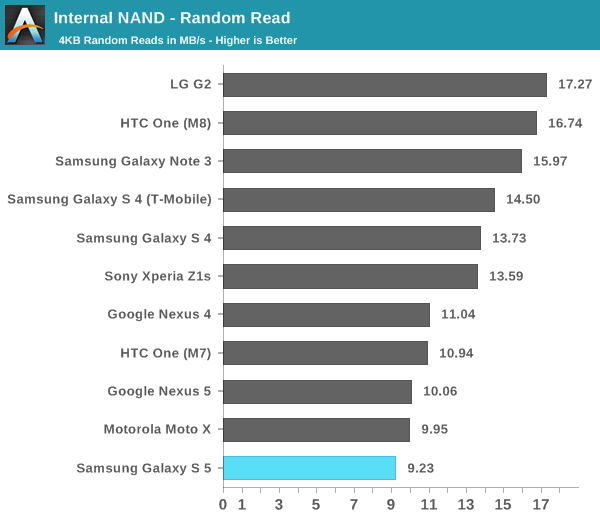
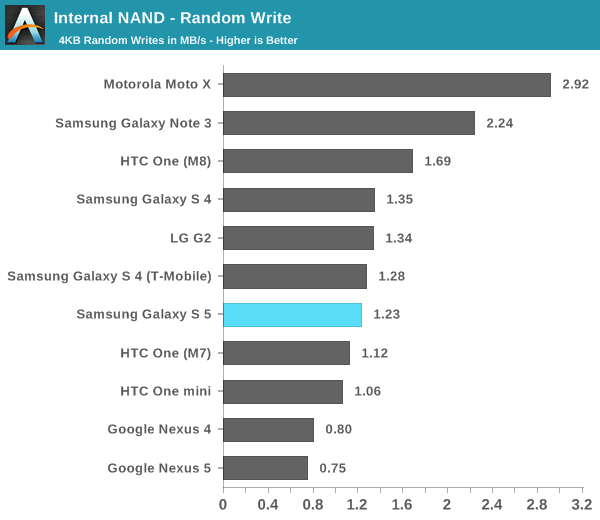
Sequential read/write performance both improve handsomely compared to the Galaxy S 4. I can see why Samsung would want to optimize for these two cases as they are quite common in regular usage, but random read/write performance can also significantly impact user experience.
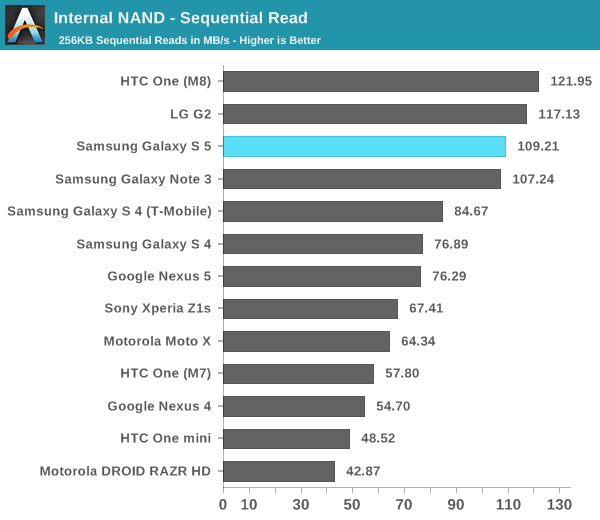
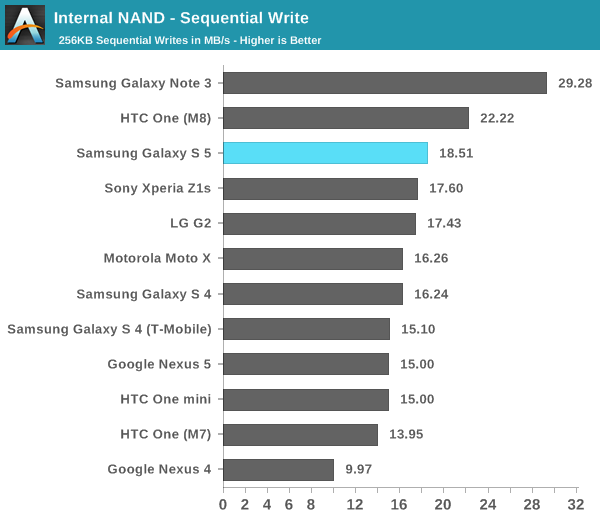










296 Comments
View All Comments
Thermogenic - Tuesday, April 8, 2014 - link
It's a shame that Nokia picture samples aren't included in comparison. Either Lumia 1020, 1520, or Icon (930). Heck, even an older 920/925 would be adequate.StevoLincolnite - Tuesday, April 8, 2014 - link
Yeah I wouldn't mind a Lumia being included in the comparisons, then we can see how every platform stacks up in these reviews.inighthawki - Tuesday, April 8, 2014 - link
On top of that it would be nice to see the results of at least some windows phones on the graphs. I can understand that a lot of windows phones have lower end hardware because they aren't very resource intensive, and thus probably don't always top the benchmarks, but it would be nice to know how they compare. Even if it's just a single entry at the bottom as an "FYI"mtoma - Tuesday, April 8, 2014 - link
I believe the review lacks the comparison with Windows 8 phones, because this site has no reviews with ANY Windows 8 phone. It just avoids them. At least Brian Klug did that. So, if he's not around, the better the things will be. Let's see if anything changes here. In the mean time, as far as smarthpones goes, I read mainly other sites.coburn_c - Tuesday, April 8, 2014 - link
Doesn't the Sony use the same camera hardware?melgross - Tuesday, April 8, 2014 - link
Did you read the whole review? If you did, you would have read that this is Samsung's own sensor this year.kyuu - Tuesday, April 8, 2014 - link
Yeah, I'm curious if Anandtech is still going to ignore Windows Phone entirely (as far as full-length reviews go) as it has since the WP8 was initially released. I guess time will tell.wrkingclass_hero - Tuesday, April 8, 2014 - link
Did Brian Klug leave? I haven't seen anything written by him in a while, and his twitter hasn't been updated.BMNify - Tuesday, April 8, 2014 - link
yeah, good to see that Brian Klug is no longer writing for Anandtech, he personally hated Windows phones and used to mock them publically. Also, there was no review for Nokia phones eventhough Nokia sent all the flagship models last year like 920,925, 1020 to Brian Klug.And from what i can make out this fiasco has led to Nokia no longer inviting Anandtech to their events and no samples too, hopefully Anand or the new writers can restore the relationship.
Myrandex - Wednesday, April 9, 2014 - link
Yea I agree they seem to ignore that platform completely. They reviewed the HTC 8X but that is the last I saw out of AT here.